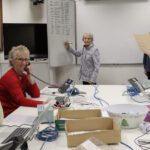Researchers from Curtin University’s Cooperative Research Centre for Remote Economic Participation, in collaboration with Ninti One, have found that despite significant barriers, many Aboriginal people in remote areas will travel great distances to participate in football.
Associate Professor Mike Dockery, Curtin’s Cooperative Research Centre for Remote Economic Participation, said a network of Aboriginal Community Researchers collected data from approximately 1,000 people in 21 remote communities around Alice Springs to understand how mobility issues affect access to services, education and employment opportunities in the desert.
“Respondents to our survey reported travelling a total of 96,000 kilometres over a number of years during overnight trips involving football, with an average distance of 480 kilometres for each football-related round trip,” Associate Professor Dockery said.
“Throughout the year, almost one out of every ten trips involved participation in football, whether that’s playing, watching or taking the kids to play, and on average adults made one trip per fortnight that involved an overnight stay away from their community.
“That figure would be considerably higher in football season.”
The communities ranged from 85 kilometres to almost 900 kilometres from Alice Springs, with only three accessible by sealed road the whole way.
“Despite the challenges of vast distances, poor road conditions and limited vehicle access or public transport, football trips are an integral part of family life for Aboriginal people in the country’s red centre,” Associate Professor Dockery said.
“It’s a real eye-opener when you see how far Aboriginal people in central Australia travel to get to the footy and the conditions under which they make those trips.
“You start to appreciate the challenges they face in accessing services and opportunities that other Australians take for granted.”
The project also identified barriers to mobility that limit service access and highlighted socio-economic engagement as a problem for delivering services.
Only 40 per cent of those surveyed held a current driver’s license and less than half had regular access to a vehicle. Those without a driver’s licence were found to be around one-third as likely to be employed.
The Population Mobility and Labour Markets survey will soon be completed and researchers expect the outcomes to contribute to better planning for infrastructure and service delivery to enhance livelihoods in remote Australia.
For more information see http://crc-rep.com/research/regional-economies/population-mobility-and-labour-markets.


